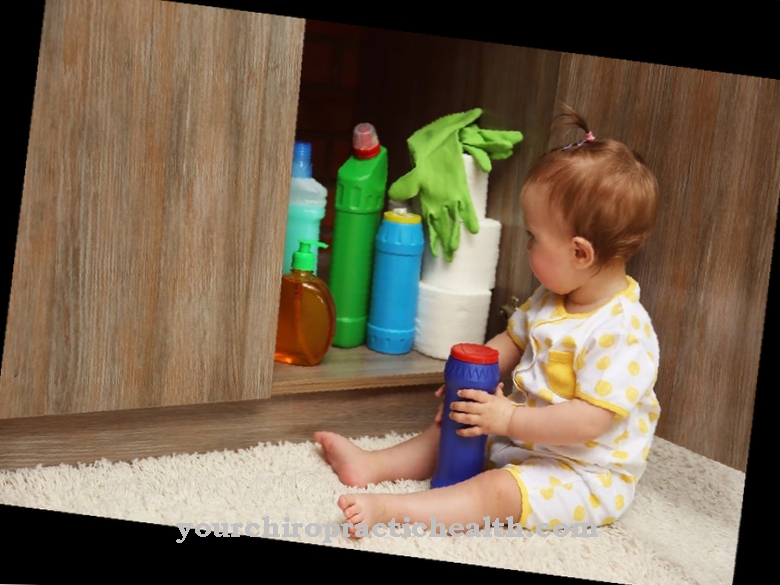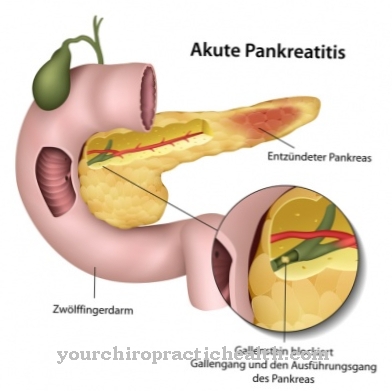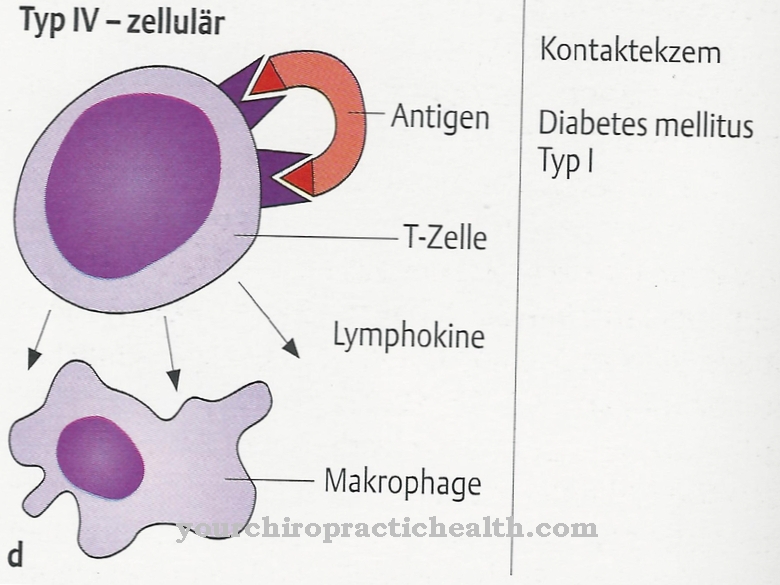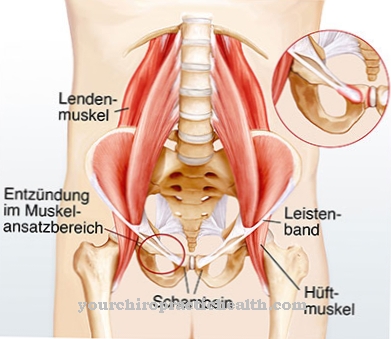Hyperhidrosis, colloquially as excessive sweating known, is characterized by excessive sweating that affects the hands, feet, and armpits. As a side effect of other diseases, it can affect the entire body surface. Hyperhidrosis is relatively harmless physically, but has strong psychological effects on patients.
What is hyperhidrosis?

© biker3 - stock.adobe.com
So far unexplained, it comes at Hyperhidrosis abnormally strong activity of the sweat glands. Primary hyperhidrosis affects the hands, feet, and armpits.
If the disease affects the entire body, it is diagnosed as secondary hyperhidrosis, which occurs as a result of a major disease. Normal sweat production is usually the body's response to heat or infection with a fever. This mechanism is disturbed in hyperhidrosis.
People experience excessive sweat production, which affects areas of the body that are usually not sweaty. This includes the sides of the hands or the tops of the feet. Hyperhidrosis can be treated with different methods depending on the severity.
causes
Scientifically proven causes of the primary Hyperhidrosis are not yet known. The nerves responsible for controlling the sweat glands react incorrectly and excessively. It is unclear what triggers this wrong reaction.
It is sometimes assumed that psychological causes such as stress or insecurity are a factor. On the other hand, a common cause of secondary hyperhidrosis is hormonal imbalances or drugs that increase sweat production. It is a well-known side effect of menopause.
Depending on the severity of the hyperhidrosis, the palms, the back of the hand or the top of the feet are affected. The combination of visible sweat production and odor development leads in many cases to the social isolation of patients suffering from hyperhidrosis. This increases the psychological stimuli that favor hyperhidrosis.
Symptoms, ailments & signs
With hyperhidrosis, the symptoms and complaints and their extent can be very different. Whether and which symptoms occur depends, among other things, on where on the body the disease occurs and what form of hyperhidrosis it is. Regardless of the shape, hyperhidrosis results in excessive sweating.
The sweat leaves large stains on clothing or footwear, which usually smell unpleasant. A lot of sweat forms on the palms of the hands, the soles of the feet and the armpits, even with light exertion. People with hyperhidrosis often suffer from accompanying symptoms such as skin irritation. Redness, itching and slight swelling are typical, for example. Occasionally, inflammation or sores will also develop in the affected areas.
From then on, the disease does not result in any further clear symptoms or complaints. However, excessive sweating can have a negative impact on the psyche. For example, many people affected suffer from inferiority complexes or depressive moods. In the long term, the emotional problems can lead to a withdrawal from social life. When treating hyperhidrosis, there are usually no symptoms. However, surgical closure of the skin glands can cause scars.
Diagnosis & course
Hyperhidrosis is initially recorded by the doctor concerned with an anamnesis. The patient's reports can pinpoint the areas of increased sweat production. A familial predisposition to hyperhidrosis is also noticeable.
For a more precise determination, the minor test can be carried out in patients who are not allergic to iodine. For the local determination of hyperhidrosis, the affected areas of the body are coated with iodine solution and, after drying, sprinkled with starch powder. Areas with increased sweat production then turn black. In the modified minor test according to Achenbach, starchy paper is used that is impregnated with iodine crystals.
The course of hyperhidrosis is stressful in the social sphere. Many sufferers tend to withdraw from other people. You suffer from hyperhidrosis and become depressed. Physical limitations result from mechanical activities. Sweaty hands due to hyperhidrosis can impair the operation of tools or keyboards.
Complications
As a rule, hyperhidrosis does not lead to physical, but severe psychological complaints and complications. The affected person suffers from excessive sweating. If the loss of fluid is not compensated for, dehydration occurs in most cases. Usually the sufferer feels ashamed leading to the symptoms of hyperhidrosis.
Sweat stains or very unpleasant smells occur, which can pollute the environment. It is not uncommon for the disease to lead to social exclusion. The person concerned often avoids events and events. Especially on hot summer days, hyperhidrosis can lead to severe psychological complaints and even depression. The pathological sweating can also have a negative effect on the relationship.
Children also suffer from the symptoms of hyperhidrosis in childhood through bullying and teasing. If dehydration occurs, this has a very negative effect on the general condition of the patient and can continue to lead to unconsciousness. Treatment of hyperhidrosis can be done by removing the sweat glands. There are usually no complications. Furthermore, drugs can also be used to prevent pathological sweating.
When should you go to the doctor?
People who suffer from prolonged intense sweating should consult a doctor. Medical clarification is particularly necessary if the hyperhidrosis has a massive impact on well-being and puts a strain on both private and professional life. If there is a lot of perspiration even with little exertion and excitement, a doctor must be consulted on the same day. Medical advice is required at the latest when accompanying symptoms such as limb, muscle, back or headache occur. External signs such as paleness and a generally sickly appearance should also be clarified.
If dizziness, rapid heartbeat and sudden attacks of sweat occur, the emergency doctor must be called. Other warning signs that need to be investigated immediately include chest pain, shortness of breath, and impaired consciousness. People who suffer from an underactive thyroid, overweight, cardiovascular disorders or mental health problems are particularly prone to hyperhidrosis. Anyone who belongs to these risk groups should speak to their family doctor if they have symptoms mentioned. Depending on the suspected cause, a dermatologist or a specialist in internal medicine can also be called in.
Doctors & therapists in your area
Treatment & Therapy
Treatment of the Hyperhidrosis in the case of a secondary disease, is to treat and cure the main disease. In the primary disease, effective antiperspirant drugs are used in milder cases.
The antiperspirant aluminum chloride also found in commercially available deodorants is particularly concentrated in the medicinal version. The active ingredient closes the pores and in some cases reduces sweat production. Therapy with botulinum toxin is also used for hyperhidrosis. It is an effective neurotoxin. The triggering nerve stimuli come to a standstill and the sweat production of hyperhidrosis is reduced to a tolerable level.
This therapy must be repeated at regular intervals. Drug therapy is possible, but it is by no means free from side effects. If the hyperhidrosis is severe, surgical interventions can be considered. This includes the removal of the sweat glands in the armpits, suction with cutting through the nerve endings in the subcutaneous tissue or cutting through nerve fibers in the chest area. Complete healing of hyperhidrosis cannot be guaranteed.
You can find your medication here
➔ Drugs against sweating and sweatingOutlook & forecast
Even without treatment, hyperhidrosis can regress or stop over time. This can often be observed in children and adolescents, where excessive sweating completely ceases after puberty. Since this can only be observed in a few cases, you should always go to the doctor. This has the advantage that the level of suffering is reduced and sweating is reduced to a minimum more quickly. Most of those affected get along well with the therapy offered. But that does not mean that success is immediate and permanent. Only those who strictly follow the instructions of the specialist will experience noticeable relief.
In the prognosis, the classification into primary or secondary also plays a role. If it is a symptom of another disease, i.e. secondary hyperhidrosis, this must be treated. The excessive sweating goes back at the same time and that permanently. The prognosis after surgical interventions varies. It depends on the type and location of the operation. In many cases it has to be done again after a few years. A visit to a specialist is essential here. Only he will be able to determine the prospect and prognosis of hyperhidrosis in a sound manner.
prevention
The prevention at Hyperhidrosis is limited. It is primarily about avoiding triggering factors such as stress or certain foods. In addition, it is advisable for those affected to choose textiles for clothing that are more suitable for the increased sweat production in hyperhidrosis, such as cotton or functional fibers.
It is not uncommon for people affected by hyperhidrosis to suffer from a loss of quality of life. Various self-help measures are recommended so that excessive sweating does not result in social withdrawal.
Aftercare
In the case of hyperhidrosis, those affected usually have only a few options or measures for direct follow-up care. First and foremost, the disease must be properly examined and treated so that there are no further complications and complaints. The earlier the hyperhidrosis is detected, the better the further course of the disease is usually.
It should also be noted that the disease can also be well limited by using the right care products. The doctor should be consulted if the use of these agents does not lead to the desired success. The affected person should make sure to change their clothes regularly.
Clothes should be changed, especially on hot days or after strenuous or sporting activities. Furthermore, special insoles for shoes can also be used to reduce perspiration. The cornea should also be reduced in order to reduce the production of sweat.
Since hyperhidrosis can in some cases also lead to depression or psychological distress, psychological counseling can also be carried out. Contact with other patients with this disease can also be useful, as this leads to an exchange of information.
You can do that yourself
If there is increased sweating below the armpits, the affected person should shave off the armpit hair. This procedure can reduce the unpleasant smell of sweat. It also makes sense to wear airy clothing made of cotton. Synthetic fibers are better to be avoided. If you have sweaty feet, it is also advisable to wear leather shoes. However, it is not advisable to use plastic or rubber shoe soles.
Body hygiene plays an important role in hyperhidrosis. It is therefore advisable to shower regularly with deodorant soap. Alternating showers and visits to the sauna are also recommended. Deodorants for hyperhidrosis should contain aluminum chloride. If excessive sweating shows up on the feet, the person concerned walks barefoot as often as possible.
Diet is also important. So it is advisable to avoid hot and spicy food. The same applies to hot and caffeinated drinks. The person affected should also reduce the consumption of tobacco products. Regular washing, foot baths and drinking sage tea can be helpful.
Psychological strategies are also considered sensible self-help measures. This includes exchanging ideas with other affected people in a self-help group as well as learning breathing techniques and relaxation methods such as autogenic training or yoga. If psychological causes are responsible for hyperhidrosis, they must be combated effectively. Professional help can also be used.
↳ More information: 10 tips against sweating













.jpg)

.jpg)
.jpg)











.jpg)